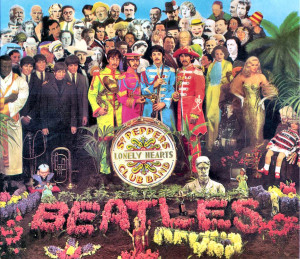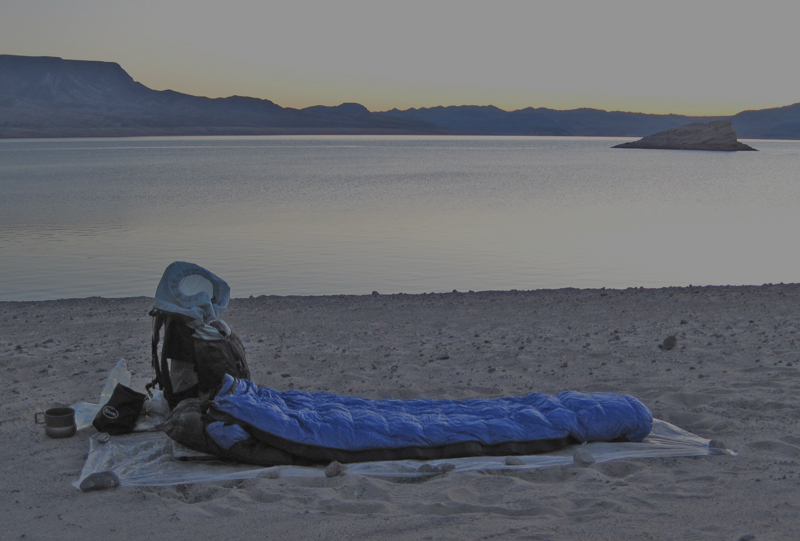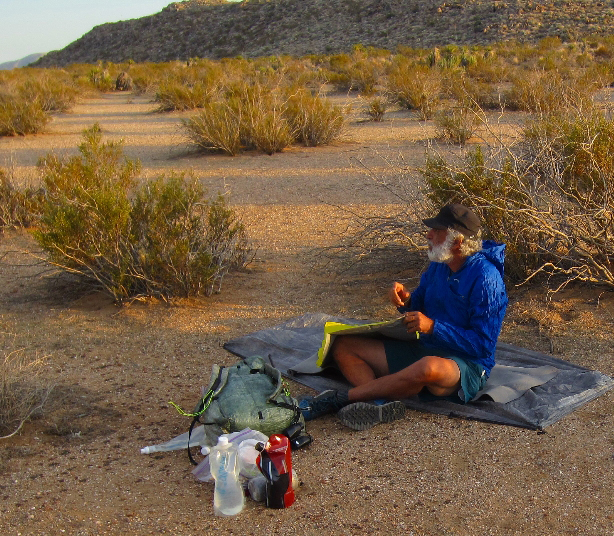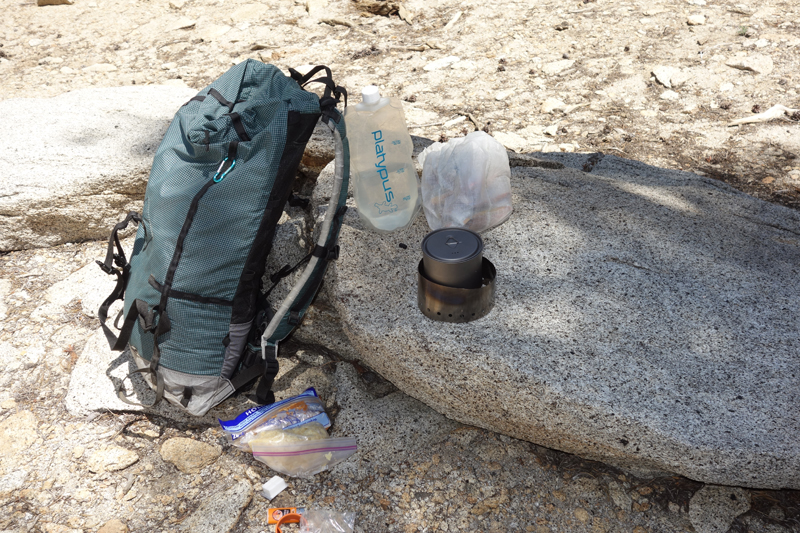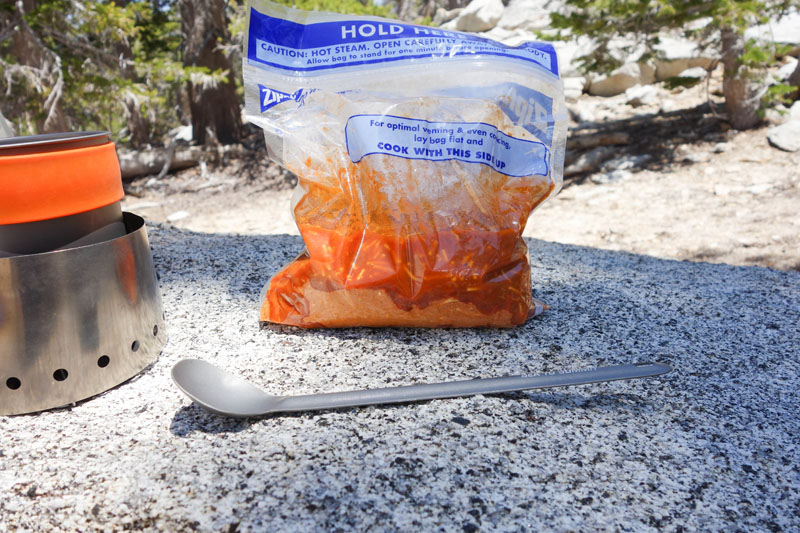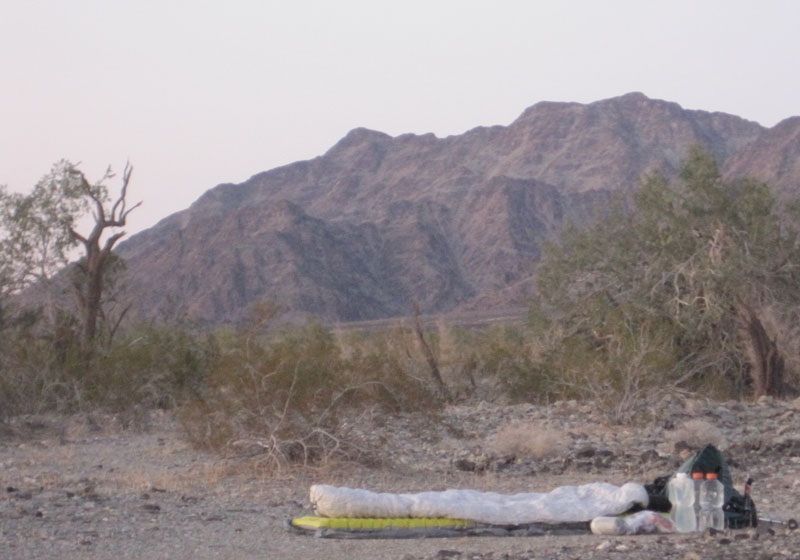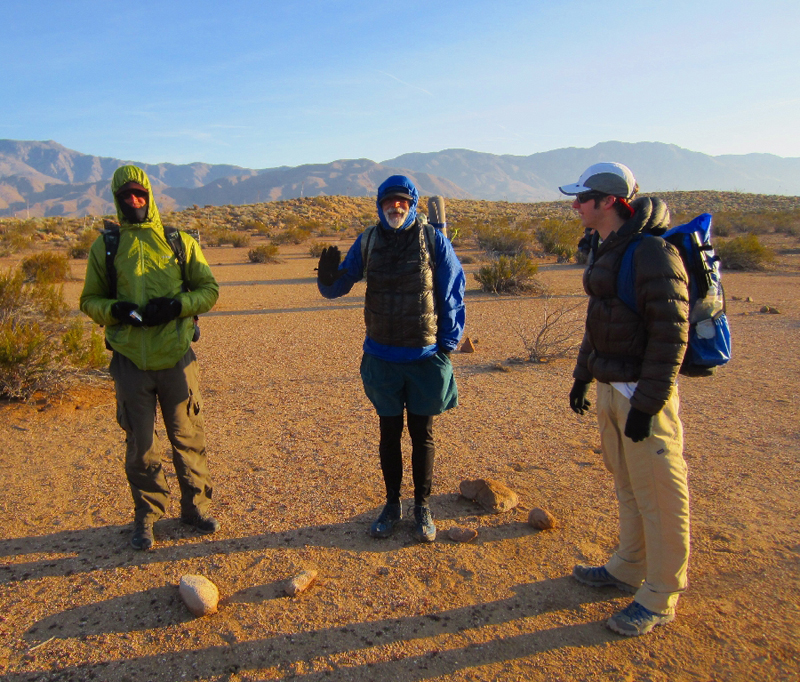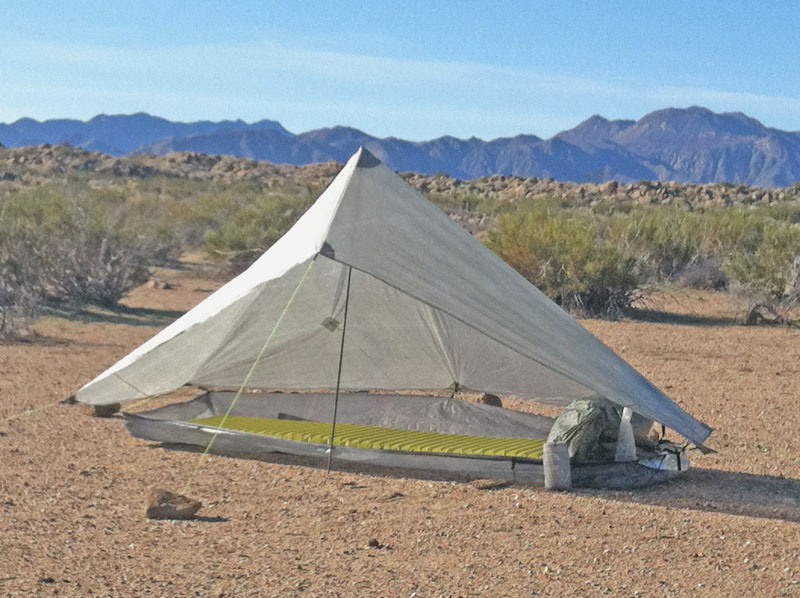Dragged a comb across my head
Found my way downstairs and drank a cup
And looking up, I noticed I was late
Found my coat and grabbed my hat
Made the bus in seconds flat
Found my way upstairs and had a smoke And somebody spoke and I went into a dream
– A Day in the Life, by The Beatles
Yesterday I was driving home on the freeway listening to the Beatles album, Sgt. Pepper’s Lonely Hearts Club Band. Often while driving I multi-task; paying attention to the task of vehicle operational control, while letting my mind drift and solving many of life’s complex mysteries and problems. Reflecting on the lyrics of A Day in the Life, I started to think about a typical day on the trail.
Given all the so-called advances in backpacking gear over the years, my daily routines have changed very little. My gear is different, but the functions aren’t. So I thought I would commit a typical trail day to electronic paper.
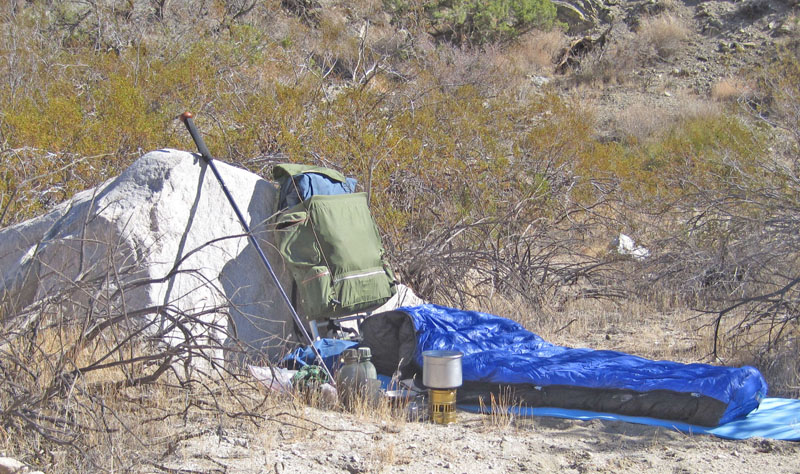
STOP AND GO
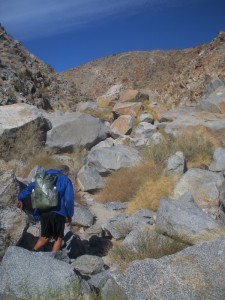 Once on the trail and hiking, I just hike. I don’t eat or drink while moving. I may stop briefly to take a picture, but I walk steadily along. I don’t fuss with my clothing. I put on what I need when I start and keep walking.
Once on the trail and hiking, I just hike. I don’t eat or drink while moving. I may stop briefly to take a picture, but I walk steadily along. I don’t fuss with my clothing. I put on what I need when I start and keep walking.
Depending upon the weather and terrain I like to stop every hour or two for a drink of water and maybe a quick snack. These stops are normally limited to 5 or 10 minutes. If I need to adjust my clothing (e.g., add or remove layers) this is the time I do it. The exception is rain. See rain gear article.
For me, these little breaks are good recovery periods. Some hikers tell me that stopping every hour or two causes their muscles and joints to stiffen up, so they walk for hours on end; eating and drinking while on the move.
Periodic stops work for me, and I find the opposite — I am re-energized after each short break.
LUNCH
Somewhere near the middle of my day, I take a longer break. Some would call this lunch. I am not going to prepare a meal; but will probably eat and drink more than my previous stops. The stop will be at a water source, if available. After this “lunch” break, which is about 30 minutes, I will continue with the 1 to 2 hour water breaks for the rest of the day.
DAY FOOD
My day food usually consists of Trail Mix, candy bars, raisins, beef jerky, and potato chips or Frito’s. What I eat at each stop is what I am hungry for. In hot weather I make sure I eat enough salt. I only drink water. I never take sport drinks or their ilk; they don’t quench my thirst and their benefits are of dubious marketing in my opinion. I have found that my body will crave the food I need, so I never pay attention to calories or the amounts of protein, fats, carbs, etc. that many hikers stress over.
NIGHT
I like to hike until just about dark. With planning I often reach a water source at the same time I stop for the day. When this happens, I set up my sleep system a short distance from water and far enough way so animals can get to water without being stressed by my presence. Once my campsite is set up, I walk to the water source and fill my water bottles. Back at camp, I slide into my quilt or sleeping bag and prepare dinner.
Should I be using an air mattress, I always blow it up first. I see that recently small air pumps have hit the market and hikers are buying them. Perplexing. Seems that if one can hike 20+ miles per day, they could blow up an air mattress. These pumps are just extra weight in my opinion.
Ample thought and observation is required to find the perfect spot. A place that won’t puddle in rain, is sheltered from wind, avoids low spots that get cold and moist during the night, and an orientation to catch the morning sun are all factors in site selection.
There are times when I need to eat before reaching my night’s campsite; usually this revolves around water sources. An example is when I get to water in the afternoon and my next water source will be another day or more away. In these instances I may cook dinner when I fill my water bottles so I can minimize the amount of water I need to carry.
Menu
For the past several decades I have been eating freeze dried foods for dinner, which only require adding boiling water to the foil pouch that contains the meal. No actual cooking is required.
A few years ago I found I could re-package these meals into freezer or microwave bags and they work as well as the heavier and bulky packaging the meals come in. This is often called Freezer Bag cooking.
Logistics
The process of boiling water and then waiting for the meal to “cook” in the bag takes about 15 to 20 minutes. I use this time to make final adjustments to my night camp. I put my shoes behind my head and store things I might need during the night in my shoes (a Photon Micro-Light II LED Flashlight on a string lanyard, toilet paper, trowel, soap, etc.). This way anything I might need during the night is within easy reach. Since I normally sleep in my hiking clothes, anything in my pockets such as compass, map, or camera go into my shoes. Water bottles are stored to my left of the sleeping area for easy access at night if I get thirsty.
Any variance from the set procedures for setting up camp and cooking dinner throw me into an inefficient frenzy. A while back I experimented with wrapping my shoes inside clothing and using that package as a pillow. It didn’t work out, because there was no place to efficiently store the odds and ends that previously were kept in the shoes.
Should I need to get up during the middle of the night, I know exactly where my light is; in my shoes. I don’t normally put on shoes to do my latrine duties, barefoot or slipping on my socks works fine. This way there is no need to empty the contents of my gear that is safely stored in the shoes. Winter requires a different strategy.
While I am getting situated for the night, and my water reaches the boiling point, I pour half of the water into my cooking bag and add a packet of instant hot chocolate to the water remaining in the pot. By the time the meal is ready, I have finished my drink. I add a little water to the pot, swirl it around and set it aside. After eating my meal, I clean my spoon with the water in the pot and drink what is left and do a final cleaning and drying of the pot and spoon with my bandanna or a handi-wipe. I place the used cooking bag into the trash bag in my pack, and situate the cooking kit near my water bottles so it will be ready for breakfast.
Contrary to what my mother tried to teach me, I don’t sit around waiting for my food to digest. Instead I simply go to sleep. Since I have probably been hiking for 12 or more hours, sleep comes easy.
Often I can set-up camp, eat dinner, and get to sleep in around 30 minutes.
BREAKFAST
Hopefully the process of selecting a proper campsite the night before has orientated me so that the early morning sun hits camp. Early morning sun helps take the bite out of those chilly mornings.
The morning meal is similar to dinner. Instant Quaker Oats oatmeal in a bag and a cup of coffee has been my staple for over 40 years. I never tire of this fare and take several different flavors. Same steps for breakfast are used for dinner with a little different twist. I cook breakfast while staying in my sleeping bag or quilt. While the water is boiling or the food is “cooking” in the bag, I am getting ready for the day’s hiking. The day’s snacks are transferred from the food bag in my backpack to pants pockets and/or outside pack pockets.
If I need to put on warm clothes before hiking, they are placed inside my sleep system to warm up. I may have slipped on a down jacket upon waking to keep my torso warm while I am prepping things. I am also organizing gear for storage in my pack.
After I finish the meal and clean the cooking kit, I get up and pack my gear. Gear is placed into the pack in the reverse order I will need them, with an eye to weight distribution and balance. Sleep system in the pack first at the bottom of the pack. Once I have finished breakfast it only takes a few minutes to pack up and hit the trail. Some hikers like to pack up and walk a while before eating breakfast, meaning they are eating on the trail. I have tried this and don’t care for it. Probably because I have to put things in the pack and then take them back out to prepare breakfast – inefficient and tasks that are done twice.
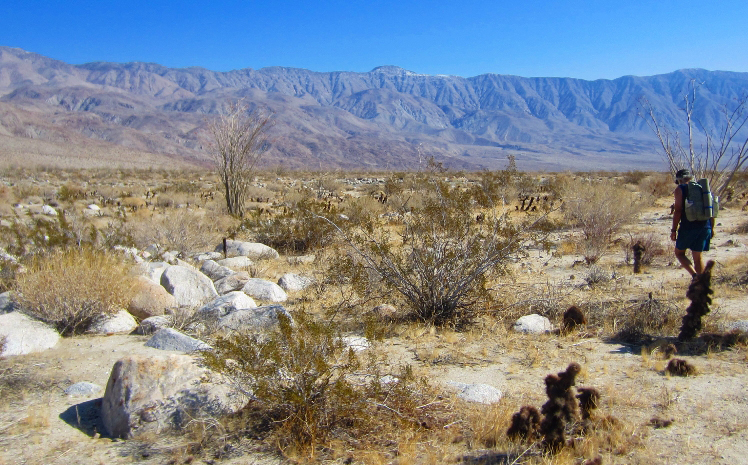
SPECIAL SITUATIONS AND VARIANCES
Bear country
I don’t eat at my campsite. I may set up camp and then cook dinner far from my campsite, or I may eat earlier than usual while on the trail and then hike an hour or two to camp. Also all food is stored away from my camp in a bear resistant canister or hung from a tall tree limb, high above the ground.
Rain or severe wind
I normally sleep under the stars without a shelter. But in poor weather I sleep under a tarp or similar shelter. My routines are the same, except for the added task of setting up or taking down the shelter. With care, I cook my meals while warmly nestled in my bedding and a roof over my head.
Under these conditions, site selection become of utmost importance. If it is raining, I am usually wearing a poncho, which has kept both me and my backpack dry. Whenever possible, I try to locate a spot under a tree or large shrub to keep the pack dry while I set up my shelter. Once the shelter is in place, I place the groundsheet, mat and sleeping bag/quilt inside. Shoes are removed and I get inside my sleep system before unpacking, cooking, and organizing gear.
Winter (cold) or snow
I am sleeping in a shelter, maybe one that more robust than a tarp style. I still cook in bed. I will have a headlamp instead of my micro Photon light as it gets dark earlier and I am often completing my day’s activities in the dark. I also bring down booties to wear at night (remember I am storing gear in my shoes).
